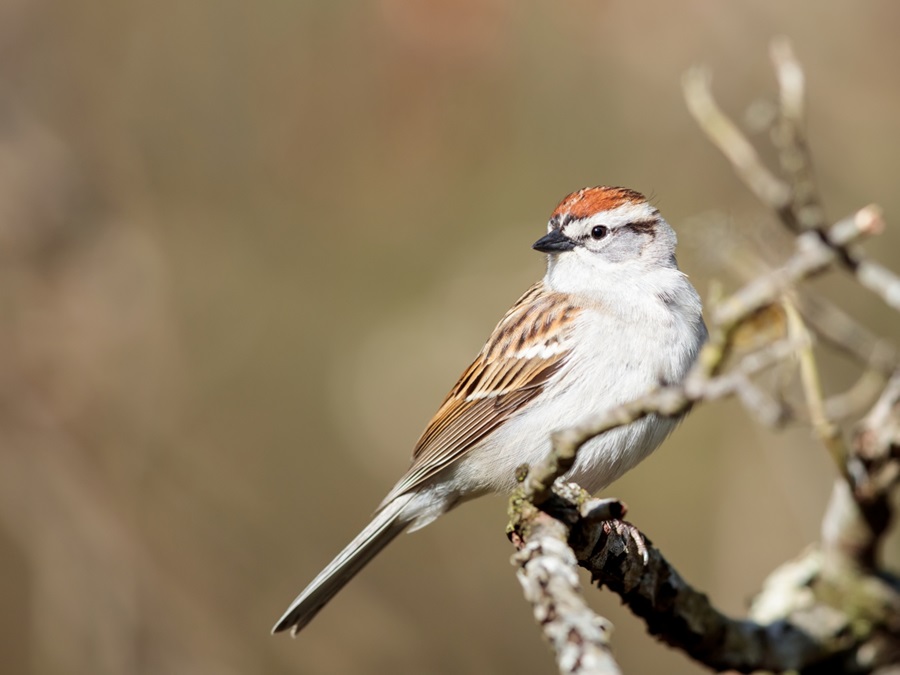I am always startled by its appearance. Streaked and mottled brown like sandy soil or like the dried blades of last year’s grasses, it rises up: a leaf? A bird. Perched. Still and observant, it watches back, allowing our intrusion. Closer to it, I stare, mesmerized by the bird’s beady black eyes, chestnut cap, and air of mystery.
Sometimes it calls right there and then. I won’t say it’s calling for us, as we are just travelers through its space. Still, its song is exciting — a repetition of one note, a sharp, short tsip that I try to mimic.
The bird stays in its place, judges my attempt, and calls out again. There is a feeling in this moment that this bird and I are all that remain and that we are dancing and communing as one. It is a little brown bird, a drab fellow, a sparrow, common and abundant. Yet this bird wields the power to stop time for an observer. It’s also a bellwether of the arrival of spring, unlike the robin, which is here long before, or the forsythia, its gaudy yellow not native to these parts. Spizella passerina, our chipping sparrow, is the mystery bird I am describing.

Sparrows are a notorious group of hard-to-identify birds. Largely seed eaters, except during breeding season, they are in a solely New World family called Emberizidae. Here in the Northeast, we encounter several others besides sparrows in this family: indigo buntings, juncos, towhees, and longspurs. When it arrives in New England in late March, the chipping sparrow has spent most of the winter in the southern parts of North America, nibbling in some fallow field.
In the 1800s, the time of John J. Audubon — that great champion of birds who wanted to document every bird on our continent but also a man who owned enslaved people and who resisted the abolitionist movement — this bird was not seen north of New Jersey. Now its migration stretches beyond Maine. It was nicknamed “chippy” by Audubon and other naturalists including Frank Chapman, who wrote of this sparrow, “One wonders why long ago he has not given up the attempt to make friends with us, so rarely do we show appreciation of his advances.” I couldn’t agree more.
On those summer days when I try to cool down in the pitch pine groves, the sap so hot that its scent wafts through the thick air, as I weave my way along a packed sand path toward the bay, it is the chippy along with the pine warblers that keeps me company. It fills my ears with its trills and my mind with the strength to press on.
Nesting in our parks, orchards, and farmland, the chippy seems to have specialized in living in a dry woodland habitat, especially oak and pine barrens; 90 percent of its nests are found in pine trees. The singing and defending of territory begins soon after the males arrive. The females alone build the nests, which are often discovered lined with hair (of horse or human), giving it the odd nickname “Hair Sparrow.”

Females will lay and incubate an average of four blue-ish green eggs with brown specks. Both sexes assist in feeding the chicks. Chipping sparrows’ nests are commonly parasitized by the brown-headed cowbird (Molothrus ater) — meaning the cowbird lays its eggs in the sparrows’ nests — which can often result in the adults abandoning the egg. Cases of brood parasitism seem to decline in northern populations, however.
You may wonder why I’d focus on such a common bird as this one. The way some people see it, those of us who are interested in observing birds should busy ourselves unearthing the mysteries of the rarer inhabitants of our landscape. But to me, this little fellow being so conspicuous and social makes him worth my attention.
It does bring me cheer when I stop and really look at it: its plumage is handsome, its crown a rufous chestnut cap with a distinct white line above a black streak through its eye. The back and wings of the chipping sparrow are filled with marbled reds, oranges, and all shades of brown. Its black beak sets it apart from its close relative, the field sparrow, Spizella pusilla, whose bill is pink. It has two white wing bars and a notched tail rounded like a cloven oar.
The cheer I feel when I see this bird, though, is really in the fact that it makes me go deeper into something considered common. There are so many commonplace objects and things in our day-to-day lives — things that go unnoticed and unappreciated, from the shape of the handle of a favorite coffee cup to another beautiful day on Cape Cod. Now I see these chippies as guides to opening up my consciousness to live in a more present state.
Watching them, I remember these lines from Common Ground, by the late Robert Finch, who also watched birds: “I hung on its every tilt and veer as onto a fragile but vital conversation, seeking in every detail and nuance of its identity some communion, direction, and purpose for my own presence here.”
